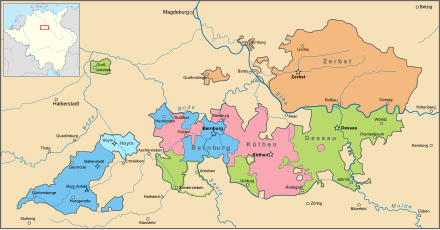Principality of Anhalt-Zerbst
The Principality of Anhalt-Zerbst came into being in 1396 as a result of various divisions of the Ascanian legacy from the older Anhalt-Köthen line . As a result, numerous branch lines formed in Anhalt, which in 1570 grew together under the leadership of Anhalt-Dessau to form a united principality of Anhalt . As early as 1603, however, the next division of the estate followed, which led to the formation of several small states. In addition to Anhalt-Zerbst, these were Anhalt-Dessau, Anhalt-Köthen, Anhalt-Bernburg and Anhalt-Plötzkau . The city of Zerbst was the royal seat of the Prince of Anhalt- Zerbst .

history
The Ascanian Margraves of Brandenburg had enfeoffed the Lords of Barby with the castle, town and surrounding area of Zerbst . In 1307 Albrecht I von Anhalt acquired this area from the Lords of Barby, initially as a Brandenburg fief . Thus it came under the rule of the Anhalt Askanier line, whose headquarters were Köthen Castle . Sigismund I ruled as co-regent with his brothers in Köthen until 1396 and then became prince in the parts of Dessau and Zerbst as a result of an inheritance, but resided, like his successors, in Dessau Castle . It was not until his great-grandson Johann IV received Anhalt-Zerbst as an independent principality in a new division of inheritance in 1544 and moved into Zerbst Castle, which had previously been inhabited by various branches of the family, as well as Roßlau Castle on the Elbe, which was also in the principality.
In 1606 all parts of Anhalt converted to the Reformed denomination , but in 1644 Anhalt-Zerbst returned to the Lutheran faith. The presence of two Protestant faiths in Anhalt, however, had no significant consequences.
In 1667 the principality inherited the rule of Jever in Friesland via a tricky inheritance . The princes themselves were seldom present in this remote part of their country and were usually represented there by a close relative. At Christmas 1717, the small area experienced a terrible storm surge disaster, the Christmas flood 1717 , which killed over a thousand people.
1667–1677 Castle Coswig was built. From 1681 to 1696, Prince Karl Wilhelm had the dilapidated Zerbst castle expanded into a baroque residence and moved his seat there. In 1674 he also took possession of the castle in the Dornburg exclave and had a new castle built there, which he ceded to his brother Johann Ludwig I.
After the death of Karl Wilhelm's son Johann August in 1742, the principality fell to the sons of Johann Ludwig von Anhalt-Zerbst-Dornburg, Johann Ludwig II. And his brother Christian August , who had previously served as a Prussian field marshal and lived in Stettin. The latter's son, Friedrich August , became Prince of Anhalt-Zerbst in 1747. Until he came of age in 1752, his mother Johanna Elisabeth ruled for him, who from 1750 had the burned down Dornburg Castle expanded as a widow's residence into a splendid baroque residence. Her brother Adolf Friedrich had ascended the Swedish throne in 1751 and her daughter, who later became Tsarina Catherine the Great , was married to the Russian heir to the throne Peter in 1743 on the advice of Frederick II of Prussia .
In the initial phase of the Seven Years' War , the princess mother and her son came into conflict with Prussia , which was at war with Russia, which is why Prussian troops occupied the principality in 1758 and the princess and her son had to flee abroad. She died two years later in Paris, while her son stayed mostly in Basel and most recently in Luxembourg . He had his country ruled by councilors, which encouraged a disorderly government during practically his entire reign. From 1778 to 1783 he sold two regiments from Zerbst and Jever (1,152 men in total) to the British Crown, which were immediately shipped to America in the rebellious colonies. Many of the soldiers did not survive the crossing or deserted after arriving in the new world.
Prince Friedrich August died in 1793 without a male heir. In 1797, the principality was divided into the Zerbst division between the other Anhalt-Bernburg , Anhalt-Köthen and Anhalt-Dessau states. The city of Zerbst itself fell to Prince Leopold Friedrich Franz von Anhalt-Dessau by lot on December 28, 1797 . The rule of Jever fell to his sister Catherine the Great because of its status as a kunkellehen and so came under Russian rule until 1818 . Friedrich August's widow, Friederike Auguste Sophie (1744–1827), was appointed there by her sister-in-law as “imperial Russian governor” and performed this service until 1806.
The name Anhalt-Zerbst lived again from 1994 to July 1, 2007 in the name of the district of Anhalt-Zerbst in the state of Saxony-Anhalt , which essentially covered the princely territory (with the exception of Jever).
See also
Lore
The archival sources of the former Principality of Anhalt-Zerbst are in the Dessau department of the Saxony-Anhalt State Archives .
literature
- Joachim Castan: Higher Education and Reformed Confessionalization. The Illustre Grammar School of the Principality of Anhalt in Zerbst, 1582-1652 .- Halle: Mitteldeutscher Verlag 1999 (= studies on regional history, 2). In it, the story of the Reformation and confessionalization of Anhalt-Zerbst in the 16th and 17th centuries.
Web links
Individual evidence
- ↑ Melanie Meyer: The escapades of the "Baron Maltzahn" . NWZOnline of December 28, 2010, accessed April 7, 2013.
- ↑ Gerhard Köbler: Historical Lexicon of the German Lands: the German territories from the Middle Ages to the present. CHBeck 2007, ISBN 3-406-54986-1 , p. 16 ff.



